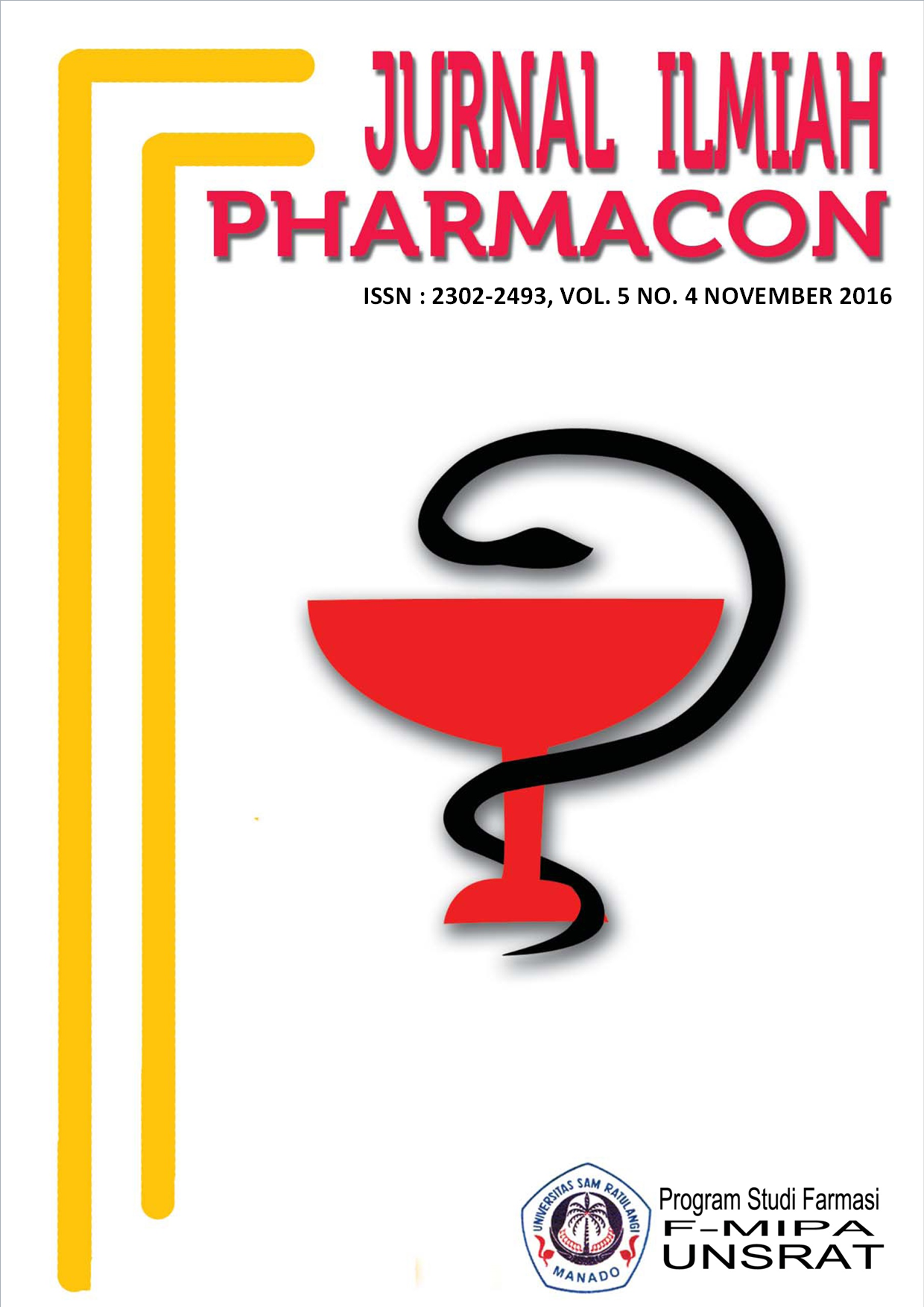UJI PELEPASAN ION LOGAM NIKEL (Ni) DAN KROMIUM (Cr) KAWAT ORTODONTIK STAINLESS STEEL YANG DIRENDAM DALAM AIR KELAPA
DOI:
https://doi.org/10.35799/pha.5.2016.13972Abstract
UJI PELEPASAN ION LOGAM NIKEL (Ni) DAN KROMIUM (Cr) KAWAT ORTODONTIK STAINLESS STEEL YANG DIRENDAM DALAM AIR KELAPA
Marchelina M. Bonde1), Fatimawali2), P. S. Anindita1)
1) Program Studi Pendidikan Dokter Gigi Fakultas Kedokteran UNSRAT Manado, 95115
2)Program Studi Farmasi FMIPA UNSRAT Manado, 95115
Â
Â
ABSTRACT
Orthodontic stainless steel archwire is one type of fixed orthodontic archwire that is often used in orthodontic treatment and have corrosion resistant, but these corrosion resistant can be influenced by the circumstances in the oral cavity. The oral cavity is an ideal environment for corrosion, due to the saliva and components which contained in saliva and low salivary pH. Consuming coconut water can cause the salivary pH becomes low. Coconut water which has a low pH could be expected to affect the corrosion process of orthodontic stainless steel archwire, that marked by nickel and chromium ions release which is bad for the body. This study aimed to determine the amount of nikel and kromium ions released from orthodontic stainless steel archwire that was immersed in saliva artificial plus coconut water. This type of research was descriptive laboratory with post-test only control group design. Sample in this research was orthodontic stainless steel archwire with three different brands and immersed in saliva artificial plus coconut water for 13 hours in an incubator at 37°C. The results were analyzed using Atomic Absorpstion Spectroscopy. The research data is presented in graphical form. The amount of nikel ions released from orthodontic stainless steel archwire that immersed in saliva artificial plus coconut water on the sample A is 4.19 ppb, sample B 38.6 and sample C 46.2 ppb and the amount of kromium ion release to the sample A is 44.8 ppb, sample B is 48.4 ppb and sample C 50.1 ppb .
Keywords : orthodontic stainless steel archwire, nickel and chrome, atomic absorpstion spectroscopy, coconut water
ABSTRAK
Kawat ortodontik stainless steel merupakan salah satu jenis kawat ortodontik cekat yang sering digunakan dalam perawatan ortodontik dan memiliki sifat tahan terhadap korosi, namun sifat ini dapat dipengaruhi oleh keadaan dalam rongga mulut. Rongga mulut merupakan lingkungan yang sangat ideal untuk terjadinya korosi, akibat adanya saliva dan komponen-komponen yang terkandung di dalamnya serta pH saliva yang rendah. Salah satu penyebab pH saliva menjadi rendah yaitu mengonsumsi air kelapa. Air kelapa yang memiliki pH rendah diduga dapat memengaruhi proses terjadinya korosi kawat ortodontik stainless steel, yang ditandai adanya pelepasan ion nikel dan kromium yang dapat berdampak buruk bagi tubuh. Penelitian ini bertujuan untuk mengetahui berapa jumLah pelepasan ion nikel dan kromium dari kawat ortodontik stainless steel yang direndam dalam saliva buatan ditambah air kelapa. Jenis penelitian ini yaitu deskriptif laboratorik dengan rancangan post-test only control group design. Sampel dalam penelitian ini yaitu kawat ortodontik stainless steel dengan tiga merek yang berbeda dan direndam dalam saliva buatan ditambah air kelapa selama 13 jam di dalam inkubator suhu 37oC. Hasil pelepasan dianalisis menggunakan alat Atomic Absorpstion Spectroscopy. Data hasil penelitian kemudian disajikan dalam bentuk grafik. JumLah ion nikel yang terlepas dari kawat ortodontik stainless steel yang direndam dalam air kelapa pada sampel A yaitu 4,19 ppb, sampel B 38,6 ppb dan sampel C 46,2 ppb dan jumLah pelepasan ion kromium pada sampel A yaitu 44,8 ppb, pada sampel B 48,4 ppb dan sampel C 50,1 ppb.
Kata kunci : kawat ortodontik stainless steel, nikel dan krom, atomic absorpstion spectroscopy, air kelapa
Downloads
Published
How to Cite
Issue
Section
License
Authors who publish with this journal agree to the following terms:
- Authors retain copyright and grant the journal right of first publication with the work simultaneously licensed under a Creative Commons Attribution-NonCommercial 4.0 International License that allows others to share the work with an acknowledgement of the work's authorship and initial publication in this journal.
- Authors are permitted and encouraged to post their work online (e.g., in institutional repositories or on their website) prior to and during the submission process, as it can lead to productive exchanges, as well as earlier and greater citation of published work (See The Effect of Open Access)










